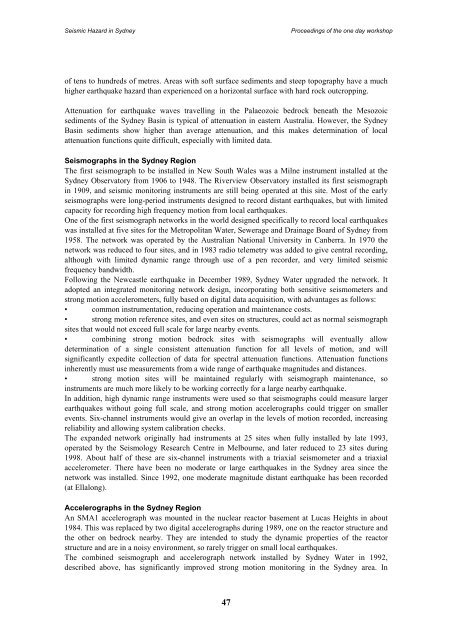Landslides in the Sydney Basin - Geoscience Australia
Landslides in the Sydney Basin - Geoscience Australia
Landslides in the Sydney Basin - Geoscience Australia
- No tags were found...
Create successful ePaper yourself
Turn your PDF publications into a flip-book with our unique Google optimized e-Paper software.
Seismic Hazard <strong>in</strong> <strong>Sydney</strong>Proceed<strong>in</strong>gs of <strong>the</strong> one day workshopof tens to hundreds of metres. Areas with soft surface sediments and steep topography have a muchhigher earthquake hazard than experienced on a horizontal surface with hard rock outcropp<strong>in</strong>g.Attenuation for earthquake waves travell<strong>in</strong>g <strong>in</strong> <strong>the</strong> Palaeozoic bedrock beneath <strong>the</strong> Mesozoicsediments of <strong>the</strong> <strong>Sydney</strong> Bas<strong>in</strong> is typical of attenuation <strong>in</strong> eastern <strong>Australia</strong>. However, <strong>the</strong> <strong>Sydney</strong>Bas<strong>in</strong> sediments show higher than average attenuation, and this makes determ<strong>in</strong>ation of localattenuation functions quite difficult, especially with limited data.Seismographs <strong>in</strong> <strong>the</strong> <strong>Sydney</strong> RegionThe first seismograph to be <strong>in</strong>stalled <strong>in</strong> New South Wales was a Milne <strong>in</strong>strument <strong>in</strong>stalled at <strong>the</strong><strong>Sydney</strong> Observatory from 1906 to 1948. The Riverview Observatory <strong>in</strong>stalled its first seismograph<strong>in</strong> 1909, and seismic monitor<strong>in</strong>g <strong>in</strong>struments are still be<strong>in</strong>g operated at this site. Most of <strong>the</strong> earlyseismographs were long-period <strong>in</strong>struments designed to record distant earthquakes, but with limitedcapacity for record<strong>in</strong>g high frequency motion from local earthquakes.One of <strong>the</strong> first seismograph networks <strong>in</strong> <strong>the</strong> world designed specifically to record local earthquakeswas <strong>in</strong>stalled at five sites for <strong>the</strong> Metropolitan Water, Sewerage and Dra<strong>in</strong>age Board of <strong>Sydney</strong> from1958. The network was operated by <strong>the</strong> <strong>Australia</strong>n National University <strong>in</strong> Canberra. In 1970 <strong>the</strong>network was reduced to four sites, and <strong>in</strong> 1983 radio telemetry was added to give central record<strong>in</strong>g,although with limited dynamic range through use of a pen recorder, and very limited seismicfrequency bandwidth.Follow<strong>in</strong>g <strong>the</strong> Newcastle earthquake <strong>in</strong> December 1989, <strong>Sydney</strong> Water upgraded <strong>the</strong> network. Itadopted an <strong>in</strong>tegrated monitor<strong>in</strong>g network design, <strong>in</strong>corporat<strong>in</strong>g both sensitive seismometers andstrong motion accelerometers, fully based on digital data acquisition, with advantages as follows:• common <strong>in</strong>strumentation, reduc<strong>in</strong>g operation and ma<strong>in</strong>tenance costs.• strong motion reference sites, and even sites on structures, could act as normal seismographsites that would not exceed full scale for large nearby events.• comb<strong>in</strong><strong>in</strong>g strong motion bedrock sites with seismographs will eventually allowdeterm<strong>in</strong>ation of a s<strong>in</strong>gle consistent attenuation function for all levels of motion, and willsignificantly expedite collection of data for spectral attenuation functions. Attenuation functions<strong>in</strong>herently must use measurements from a wide range of earthquake magnitudes and distances.• strong motion sites will be ma<strong>in</strong>ta<strong>in</strong>ed regularly with seismograph ma<strong>in</strong>tenance, so<strong>in</strong>struments are much more likely to be work<strong>in</strong>g correctly for a large nearby earthquake.In addition, high dynamic range <strong>in</strong>struments were used so that seismographs could measure largerearthquakes without go<strong>in</strong>g full scale, and strong motion accelerographs could trigger on smallerevents. Six-channel <strong>in</strong>struments would give an overlap <strong>in</strong> <strong>the</strong> levels of motion recorded, <strong>in</strong>creas<strong>in</strong>greliability and allow<strong>in</strong>g system calibration checks.The expanded network orig<strong>in</strong>ally had <strong>in</strong>struments at 25 sites when fully <strong>in</strong>stalled by late 1993,operated by <strong>the</strong> Seismology Research Centre <strong>in</strong> Melbourne, and later reduced to 23 sites dur<strong>in</strong>g1998. About half of <strong>the</strong>se are six-channel <strong>in</strong>struments with a triaxial seismometer and a triaxialaccelerometer. There have been no moderate or large earthquakes <strong>in</strong> <strong>the</strong> <strong>Sydney</strong> area s<strong>in</strong>ce <strong>the</strong>network was <strong>in</strong>stalled. S<strong>in</strong>ce 1992, one moderate magnitude distant earthquake has been recorded(at Ellalong).Accelerographs <strong>in</strong> <strong>the</strong> <strong>Sydney</strong> RegionAn SMA1 accelerograph was mounted <strong>in</strong> <strong>the</strong> nuclear reactor basement at Lucas Heights <strong>in</strong> about1984. This was replaced by two digital accelerographs dur<strong>in</strong>g 1989, one on <strong>the</strong> reactor structure and<strong>the</strong> o<strong>the</strong>r on bedrock nearby. They are <strong>in</strong>tended to study <strong>the</strong> dynamic properties of <strong>the</strong> reactorstructure and are <strong>in</strong> a noisy environment, so rarely trigger on small local earthquakes.The comb<strong>in</strong>ed seismograph and accelerograph network <strong>in</strong>stalled by <strong>Sydney</strong> Water <strong>in</strong> 1992,described above, has significantly improved strong motion monitor<strong>in</strong>g <strong>in</strong> <strong>the</strong> <strong>Sydney</strong> area. In47
















